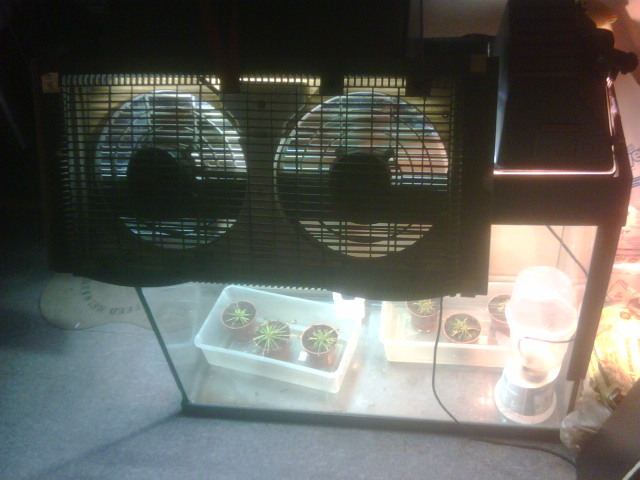Question
 My Terrarium
My Terrarium
Hello Jeff;
Sorry I was not as clear as I could have been ?Yes, the tank I will be using for my terrarium was originally a marine aquarium. I have not yet converted it. My plans are to convert it to a BOG Environment with FISH.
I have seen many bog terrarium environment setup, from the internet but thought I would add goldfish to mine. Thank you! I could not clarify if adding fish to my system was a good idea or not ?you answer that question for me without knowing it was a concern.
My plants are sitting in (2) containers inside the tank.
At this time the 250 metal halide and 100 high pressure sodium lights are 31?away from the plants. I plan to move them about 3?above the terrarium to reduce the amount of heat inside the terrarium when I permanently set-up.
The reasons I have so many lights ?when I first bought the plants I place them under a 300 watt incandescent lamp.
In my research I discovered incandescent lighting is not a good lamp for plants ?so I replaced the incandescent lamp with (2) 42 watt compacted fluorescent fixtures but later discovered HID lamps are the best artificial lights for plant growth according to my research.
I live in an apartment and have to use artificial lighting
The fan is blowing somewhat on the plants because it抯 angled to blow on the MH250 watt fixture and some air flows inside the tank. Should I stop any air from flowing onto the plants?
Being a beginner at growing carnivorous plants, I抦 researching and collecting as much information about the Cape sundews habits, environment, and possible growing dangers.
I was not aware you have a DVD and e-literature about carnivorous plants I will surely get a set
I notice new growth today in each pot and even little plantlets under the main plant it seems they have begun to adjust to my set-up but the leaves are still burned brown.
THANK YOU
Gilbert
AnswerHi Gilbert,
Thank-you for sending the photo and explanation. That is a great help. You mentioned something that you didn't say in your first post, and that was about the incandescent light. That was what burned your plants. Incandescent lights are hot, and too yellow-orange.
Here's my take on this. Because marine tanks are designed to simulate tropical, equatorial sun, it is very intense, especially since the light needs to go through water. I'm sure they help heat the water too. As a plant terrarium, however, it is way too much. Even though they like the bright light, you'll constantly battle the high temperatures in a small enclosure. This will give you nothing but grief trying to grow your plants this way.
I'm getting the impression that you've read/heard that carnivorous plants need a high humidity environment. It's a myth. There's a grain of truth like all myths (some Nepenthes, Wooly sundews), but the majority of carnivorous plants can adapt just fine to normal humidity conditions.
Here's the good news. You already have great equipment for an apartment grow area. If you set up a shelf with one of your HID lights, you can place several plants underneath it with your water trays. Suspend the lights about a foot above your plants. You may need to adjust this based on heat, so you could start further up, and move the light down if plants look too pale. Make sure the plants always have a little water to set in. Being out in the open will keep them from being too hot, yet will be very bright which Cape Sundews love. This same approach will work well for many other tropical sundews and Mexican butterworts. It would also allow you to grow many intermediate and highland Nepenthes species. Cephalotus would also do well here.
I'm going to make another shameless plug here, but our DVD set will be a solid investment. I know folks often think, " I can find all the information I need on the Internet", but as you're probably discovering already, it's hit and miss, and you don't know the experience level of the writers. What we sought to do with the videos is to create "hands-on, how-to" guides based on our 25+ years of experience. This is harder to do in a book. As a result we show you how to position plants, what full-sun looks like, how to mix soil, propagation, repotting, etc... We also get into detail on what to avoid and common mistakes. We cover artificial lighting in volume #2, but we didn't include information on HID lights since these are usually more money that most people want to spend when first starting out.
Good Growing!
Jeff Dallas
Sarracenia Northwest
http://www.cobraplant.com






